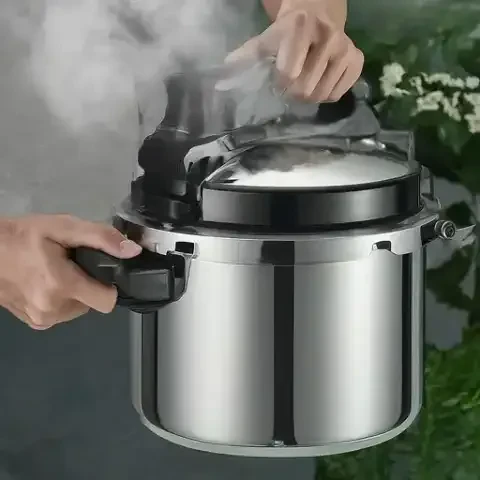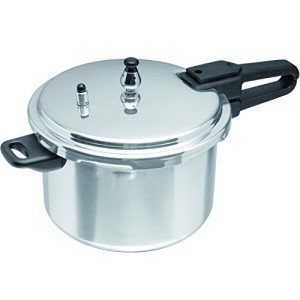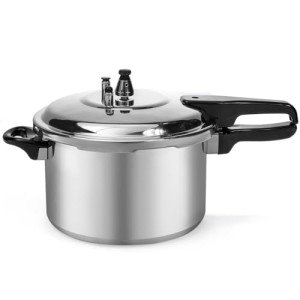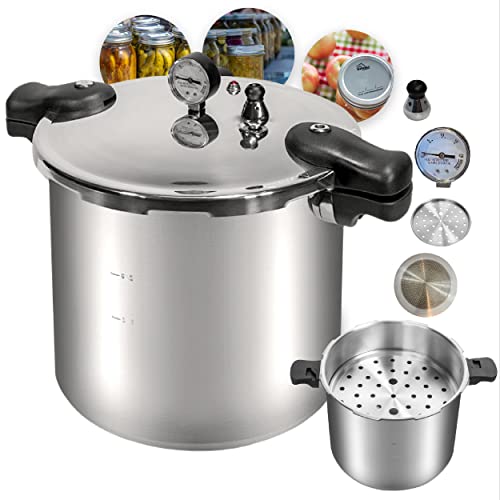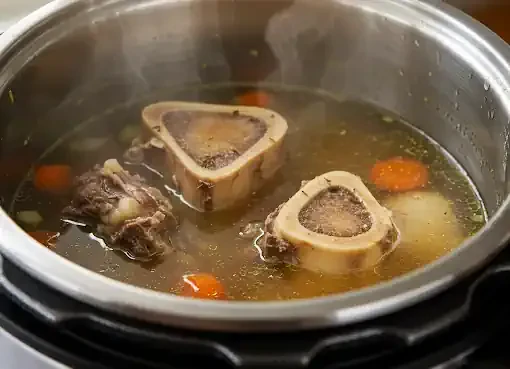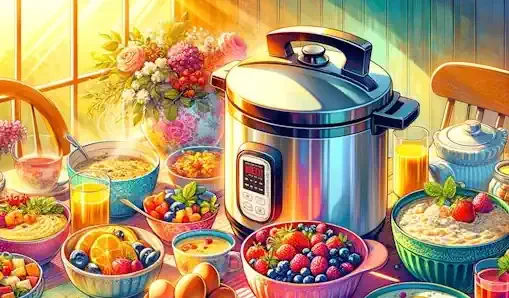Introduction
Pressure cookers have revolutionized the way we cook, offering convenience, speed, and efficiency in preparing meals. From their humble beginnings to their modern electric counterparts, pressure cookers have evolved to become an essential kitchen appliance for many households worldwide. In this section, we'll explore a brief history of the pressure cooker, highlighting its journey from inception to innovation. Additionally, we'll delve into the numerous benefits of using a pressure cooker, including its ability to save time, retain nutrients in food, and contribute to energy savings, particularly in the context of electric pressure cookers.
Understanding Your Pressure Cooker
A pressure cooker is comprised of several key components, each playing a vital role in its operation. Familiarizing yourself with these components is essential for safe and efficient use:
Lid: The lid of a pressure cooker seals tightly to create a pressurized environment inside the pot. It typically features a locking mechanism to secure it during cooking.
Gasket: The gasket, also known as the sealing ring, is a rubber or silicone ring fitted around the inside edge of the lid. It helps to create an airtight seal, preventing steam from escaping during cooking.
Valve: The pressure release valve is a crucial safety feature of a pressure cooker. It allows excess steam to escape to maintain optimal pressure levels inside the pot. Some pressure cookers have multiple valve settings for different cooking methods.
Pressure indicator: This component indicates whether the pressure cooker is under pressure or depressurized. It may consist of a visual indicator, such as a colored pin or marker, that rises when the cooker is pressurized.
Handles: Pressure cookers are equipped with sturdy handles for safe handling and transport, especially when the pot is hot or filled with food.
Differences between stovetop and electric models:
Stovetop pressure cookers are designed to be used on traditional gas or electric stovetops. They rely on direct heat from the stove to generate pressure and cook food. These models often offer greater control over pressure levels and cooking times but require more attention during cooking to maintain consistent pressure.
On the other hand, electric pressure cookers, also known as multi-cookers, feature built-in heating elements and electronic controls. They offer convenience and versatility, allowing users to set precise cooking times and pressure levels with the push of a button. Electric pressure cookers often include additional functions such as sautéing, steaming, and slow cooking.
Capacity and size options:
Pressure cookers come in various capacities to suit different cooking needs. Common sizes include 4-quart, 6-quart, and 8-quart models, although larger and smaller options are also available. When choosing a pressure cooker, consider the size of your household and the types of meals you typically prepare. Larger families may opt for larger capacities, while smaller households or individuals might prefer more compact sizes for everyday use. Additionally, ensure that the pressure cooker fits comfortably in your kitchen and storage space.
Safety Features
Pressure cookers are equipped with various safety features to prevent accidents and ensure safe operation in the kitchen. Understanding these features is crucial for minimizing risks and enjoying worry-free cooking experiences:
Locking Lids: One of the fundamental safety features of pressure cookers is their locking lids. These lids seal tightly during cooking, preventing the release of steam and pressure. Most pressure cookers incorporate a mechanism that prevents the lid from being opened when the pot is pressurized, reducing the risk of burns from hot steam or food spillovers.
Pressure Release Mechanisms: Pressure cookers feature mechanisms for releasing excess steam and pressure during cooking. This can include a pressure release valve or a quick-release button. These mechanisms allow users to safely depressurize the cooker before opening the lid, preventing sudden bursts of steam and potential hazards.
Overpressure Plug: In the event of excessive pressure buildup, pressure cookers are equipped with an overpressure plug or safety valve. This component serves as a fail-safe measure by releasing pressure if it exceeds safe levels, preventing the cooker from exploding or causing damage to the surroundings.
Importance of Not Overfilling: Overfilling a pressure cooker can lead to dangerous situations, including food spillovers, clogging of pressure release mechanisms, and increased risk of burns. It's essential to follow the manufacturer's guidelines regarding maximum fill levels and avoid exceeding the recommended capacity of the cooker. Leaving adequate space for steam expansion is crucial for maintaining safe pressure levels and ensuring proper cooking results.
By adhering to these safety features and guidelines, users can confidently harness the efficiency and convenience of pressure cooking while prioritizing the safety of themselves and others in the kitchen.
Before You Begin
Before using a pressure cooker, it's essential to take several preparatory steps to ensure safe and successful cooking experiences. These preliminary measures help familiarize users with the equipment and minimize potential risks:
Reading the Manual: The user manual provided with the pressure cooker contains valuable information regarding its operation, safety guidelines, and maintenance instructions. Take the time to thoroughly read and understand the manual before using the cooker for the first time. Pay close attention to specific features, recommended cooking techniques, and any safety precautions outlined by the manufacturer.
Checking for Damage or Wear: Inspect the pressure cooker carefully for any signs of damage, wear, or defects. This includes examining the lid, sealing ring, pressure release valve, and other components for cracks, dents, or corrosion. Ensure that all parts are securely attached and functioning correctly. Using a damaged pressure cooker can compromise safety and cooking results, so it's crucial to address any issues before proceeding.
Essential Accessories: Depending on the model and intended use, pressure cookers may come with or require additional accessories to enhance versatility and functionality. Common accessories include a steamer basket for cooking vegetables or seafood, a trivet for elevating food above liquid, and a spare sealing ring for replacement. Familiarize yourself with these accessories and ensure they are clean and in good condition before beginning the cooking process.
By following these preparatory steps, users can set the stage for safe and successful pressure cooking adventures. Taking the time to read the manual, inspect the cooker for damage, and gather essential accessories ensures a smooth and enjoyable cooking experience while prioritizing safety and optimal results.
Basic Steps for Using a Pressure Cooker
Using a pressure cooker may seem daunting at first, but following a few simple steps can help you harness its full potential and achieve delicious results with ease. Here's a guide to the basic steps involved in using a pressure cooker:
Adding Liquid and Ingredients: Begin by adding the required amount of liquid, such as water, broth, or sauce, to the pressure cooker pot. The liquid is essential for creating steam, which builds pressure inside the cooker and cooks the food. Next, add the ingredients you wish to cook, ensuring they are evenly distributed in the pot.
Closing the Lid and Ensuring it's Sealed: Once the ingredients and liquid are in the pot, securely close the lid of the pressure cooker. Ensure that the lid is properly aligned and tightly sealed to prevent steam from escaping during cooking. For stovetop pressure cookers, align the lid with the pot and twist it to lock into place. Electric pressure cookers typically feature a locking mechanism that engages when the lid is closed properly.
Setting the Pressure Level: Depending on the recipe and desired cooking time, select the appropriate pressure level on your pressure cooker. Most pressure cookers offer two pressure settings: high pressure and low pressure. High pressure is ideal for quickly cooking tough cuts of meat and dense ingredients, while low pressure is suitable for delicate foods and more precise cooking tasks.
Starting the Cook and Adjusting the Heat (for Stovetop Models): If you're using a stovetop pressure cooker, place it on the stove over medium to high heat to bring the liquid inside to a boil. Once steam begins to escape from the pressure release valve, indicating that the cooker has reached the desired pressure level, reduce the heat to maintain a steady pressure. Follow the recipe instructions for the recommended cooking time.
Natural Release Methods: After cooking is complete, there are two primary methods for releasing the pressure from the cooker: natural release and quick release. Natural release involves allowing the pressure to dissipate gradually on its own, typically by turning off the heat and letting the cooker sit undisturbed for a specified period. This method is suitable for foods that benefit from additional cooking time or for delicate ingredients that may become overcooked with rapid pressure release.
By following these basic steps, you can confidently use your pressure cooker to prepare a wide range of delicious meals with efficiency and ease. Experiment with different recipes and cooking techniques to unlock the full potential of this versatile kitchen appliance.
Tips for Successful Pressure Cooking
Pressure cooking is a versatile and efficient cooking method that can yield delicious results with proper technique and attention to detail. Here are some valuable tips to help you achieve successful pressure cooking experiences:
Adjusting Recipes for High Altitude: If you live at a high altitude, cooking with a pressure cooker may require slight adjustments to account for lower atmospheric pressure. At higher altitudes, water boils at a lower temperature, which can affect cooking times and results. To compensate, increase cooking times slightly or adjust pressure settings as needed. Consult altitude-specific cooking guides or experiment with recipes to find the optimal adjustments for your location.
Dealing with Foamy Foods: Certain foods, such as legumes and grains, can produce foam during pressure cooking, which may lead to clogging of the pressure release valve or uneven cooking. To prevent foaming, rinse these foods thoroughly before cooking and add a small amount of oil or fat to the cooking liquid. Additionally, avoid filling the pressure cooker beyond its recommended capacity when cooking foamy foods to minimize the risk of overflow.
Layering Ingredients for Optimal Cooking: When preparing recipes with multiple ingredients, such as stews or soups, layering ingredients strategically can help ensure even cooking and enhance flavor infusion. Start by placing denser ingredients, such as meat or root vegetables, at the bottom of the pressure cooker, followed by softer vegetables and liquids on top. This layering technique promotes efficient heat distribution and prevents ingredients from sticking to the bottom of the pot.
Partial or Full Filling of the Cooker: The recommended filling level for a pressure cooker depends on the type of food being cooked and the cooking method. For recipes that require ingredients to expand during cooking, such as grains, beans, or soups, fill the pressure cooker only halfway to two-thirds full to allow sufficient space for expansion and prevent overflow. For recipes that do not require ingredients to expand significantly, such as meats or vegetables, you can fill the cooker closer to its maximum capacity.
By following these tips and techniques, you can maximize the potential of your pressure cooker and enjoy consistently delicious results with every meal. Experimentation and practice will help you refine your pressure cooking skills and adapt recipes to suit your preferences and cooking environment.
Cleaning and Maintenance
Proper cleaning and maintenance of your pressure cooker are essential for ensuring its longevity, performance, and safety. Follow these guidelines to keep your pressure cooker in optimal condition:
Washing and Storing the Pressure Cooker: After each use, carefully wash the pressure cooker components, including the pot, lid, sealing ring (gasket), pressure release valve, and any accessories, with warm, soapy water. Use a non-abrasive sponge or cloth to remove any food residue or stains. Rinse thoroughly and allow the parts to air dry before reassembling the cooker. Avoid using harsh abrasives or abrasive cleaning pads, as they can damage the cooker's surfaces.
When storing the pressure cooker, ensure that all parts are completely dry to prevent the growth of mold or mildew. Store the cooker with the lid slightly ajar to allow air circulation and prevent odors from developing. Store it in a cool, dry place away from direct sunlight and moisture.
Replacing the Gasket and Valve as Needed: Over time, the sealing ring (gasket) and pressure release valve of your pressure cooker may wear out or become damaged, compromising their effectiveness. Check these components regularly for signs of wear, such as cracks, tears, or deformation. If you notice any damage, replace the gasket or valve with genuine manufacturer-approved parts to maintain the cooker's seal and safety features.
Refer to the user manual for instructions on how to properly remove and replace the gasket and valve. Some models may require periodic lubrication of the gasket with food-grade silicone grease to ensure a tight seal and prevent leakage.
Troubleshooting Common Issues: If you encounter any issues with your pressure cooker, such as difficulty building pressure, steam leakage, or unusual noises, refer to the troubleshooting section of the user manual for guidance. Common issues may include improper assembly, clogged pressure release valves, or worn gaskets. Follow the recommended troubleshooting steps to identify and resolve the problem.
If you are unable to resolve the issue on your own or if you suspect a mechanical problem with the cooker, contact the manufacturer or authorized service center for assistance. Avoid attempting to repair or modify the pressure cooker yourself, as this may void the warranty or compromise safety.
By following these cleaning and maintenance practices, you can prolong the lifespan of your pressure cooker and enjoy safe, reliable cooking for years to come. Regular inspection, cleaning, and replacement of worn parts will help ensure that your pressure cooker continues to perform at its best.
Recipes to Get You Started
Whether you're new to pressure cooking or looking to expand your culinary repertoire, here are a few recipes to help you get started and make the most of your pressure cooker:
Simple Starter Recipe: Pressure Cooker Chicken and Rice
Ingredients:
1 lb (450g) boneless, skinless chicken thighs or breasts, cut into bite-sized pieces
1 cup (200g) long-grain white rice, rinsed
1 ½ cups (375ml) chicken broth
1 small onion, diced
2 cloves garlic, minced
1 teaspoon dried thyme
Salt and pepper to taste
Optional: chopped fresh parsley for garnish
Instructions:
In the pressure cooker pot, combine the chicken, rice, chicken broth, diced onion, minced garlic, dried thyme, salt, and pepper.
Close the lid of the pressure cooker and ensure it's properly sealed.
Select the high-pressure setting and set the cooking time to 8 minutes.
Once the cooking cycle is complete, allow for a natural release of pressure for 5 minutes, then carefully perform a quick release to release any remaining pressure.
Open the lid carefully, fluff the rice with a fork, and serve the chicken and rice hot, garnished with chopped parsley if desired.
Intermediate Recipe: Pressure Cooker Beef Stew
Ingredients:
1 ½ lbs (680g) beef stew meat, cut into 1-inch cubes
4 cups (1 liter) beef broth
2 cups (300g) baby potatoes, halved
2 carrots, peeled and chopped
1 onion, diced
2 cloves garlic, minced
2 tablespoons tomato paste
1 teaspoon dried thyme
Salt and pepper to taste
2 tablespoons olive oil
2 tablespoons all-purpose flour (optional, for thickening)
Instructions:
In the pressure cooker pot, heat the olive oil using the sauté function. Add the diced onion and minced garlic, and sauté until softened.
Add the beef stew meat to the pot and brown on all sides.
Stir in the tomato paste, dried thyme, salt, and pepper.
Pour in the beef broth and add the halved baby potatoes and chopped carrots.
Close the lid of the pressure cooker and ensure it's properly sealed.
Select the high-pressure setting and set the cooking time to 35 minutes.
Once the cooking cycle is complete, allow for a natural release of pressure for 10 minutes, then perform a quick release to release any remaining pressure.
If desired, thicken the stew by mixing 2 tablespoons of flour with a small amount of water to create a slurry. Stir the slurry into the stew and simmer on the sauté function until thickened.
Serve the beef stew hot, garnished with fresh herbs if desired.
Where to Find More Pressure Cooker Recipes:
There are numerous resources available for discovering new and exciting pressure cooker recipes. Consider exploring the following:
Online recipe websites and blogs dedicated to pressure cooker cooking, such as Pressure Cooking Today, Instant Pot Eats, and Simply Recipes.
Cookbooks specifically focused on pressure cooking, featuring a wide range of recipes for appetizers, mains, sides, and desserts.
Social media platforms like Pinterest and Instagram, where users share their favorite pressure cooker recipes and cooking tips.
Community forums and discussion groups, where pressure cooker enthusiasts exchange recipe ideas, troubleshooting advice, and cooking inspiration.
With a bit of experimentation and creativity, you'll soon discover a world of delicious possibilities waiting to be explored with your pressure cooker. Happy cooking!
How to Use a Pressure Cooker
As you embark on your pressure cooking journey, it's essential to remember the importance of following safety guidelines to ensure enjoyable and risk-free culinary experiences. From properly sealing the lid to releasing pressure safely, adhering to these guidelines is key to preventing accidents and maximizing the benefits of your pressure cooker.
Furthermore, don't hesitate to experiment with a variety of dishes and ingredients to discover the full potential of your pressure cooker. Whether you're whipping up quick weeknight meals or preparing elaborate feasts, the versatility of this kitchen appliance offers endless possibilities for creativity and innovation in the kitchen.
Beyond the convenience and efficiency of pressure cooking, it's worth noting the environmental and nutritional benefits it offers. Pressure cookers use less energy and water compared to traditional cooking methods, contributing to reduced environmental impact and energy savings. Additionally, the sealed environment of pressure cooking helps retain nutrients in food, ensuring that your meals are not only delicious but also nourishing.
Incorporating pressure cooking into your culinary repertoire can elevate your cooking experience, allowing you to create flavorful, nutritious meals with ease. So, embrace the possibilities, explore new recipes, and enjoy the many rewards of pressure cooking in your kitchen. Happy cooking!
